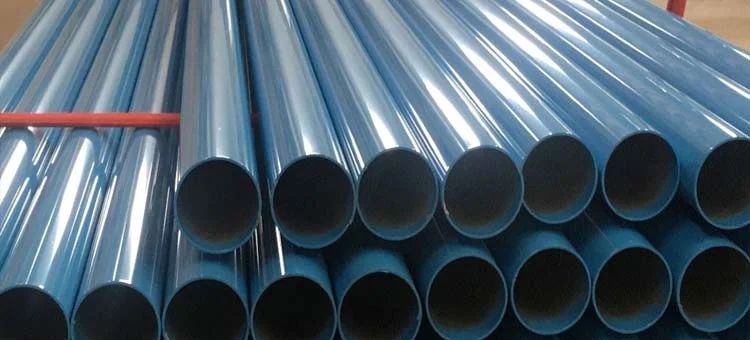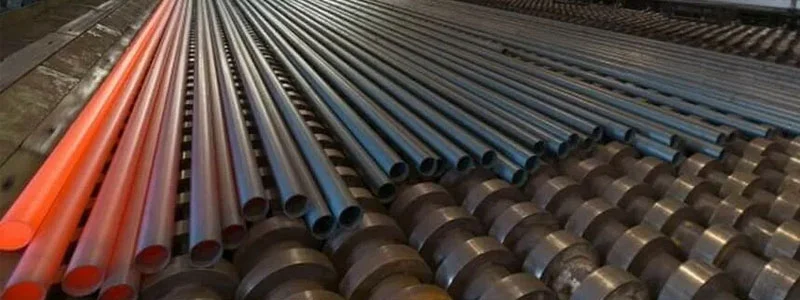Powder Coated Pipe: Enhancing Durability and Aesthetics in Industrial Applications
Powder coating is a highly utilized technique for bestowing both protection and aesthetic appeal to a diverse range of surfaces, encompassing metals, plastics, and even wood. This method entails the application of a dry powder substance onto an object's surface, followed by a heating process that fuses the powder into a robust and visually appealing coating. Its broad applicability across industries such as automotive, manufacturing, and construction is rooted in its manifold advantages, including resilience, eco-friendliness, and adaptability.

The application of the powder coated pipe represents a specialized use within this field, frequently employed in sectors like construction, plumbing, and infrastructure development. This specific process imparts a protective layer to pipes, effectively thwarting corrosion, prolonging their operational life, and augmenting their overall visual appeal.
Benefits of Powder Coating
Enhanced Durability
1) Resistance to Chipping, Scratching, and Physical Damage: Powder-coated pipes exhibit exceptional durability, effectively resisting chipping, scratching, and various forms of physical damage. This makes them particularly suitable for use in demanding environments where pipes may encounter abrasion or impacts.
2) Superior Rust and Corrosion Protection: Powder coating stands out as a primary defense against rust and corrosion. The coating forms a protective barrier that effectively shields pipes from moisture and corrosive agents, significantly prolonging the pipes' useful lifespan.
3) Extended Longevity and Service Life: By fortifying resistance to both physical harm and corrosion, powder coating plays a pivotal role in extending the overall longevity and service life of pipes. This translates into reduced maintenance expenses and an extended operational lifespan for the coated pipes.
Enhanced Aesthetics
1) Consistent and Smooth Finish: Powder coating consistently delivers a uniform and smooth finish to pipes. Unlike traditional painting methods that may result in uneven coverage or unsightly drips, powder coating ensures a flawless appearance, enhancing the visual appeal of the pipes.
2) Diverse Range of Colors and Finishes: Powder coating offers an extensive palette of colors and finishes to choose from. Whether the requirement is for pipes in a specific color for identification purposes or to align with a particular design theme, the versatility of powder coating accommodates a wide array of options.
3) Customized Designs and Branding: Powder coating empowers the creation of bespoke designs and branding on pipes. This flexibility proves especially valuable for businesses seeking to incorporate logos, labels, or other distinctive markings on their pipes, facilitating easy recognition and reinforcing brand identity.
How Powder Coating Works
Preparing the Pipe
Thorough Cleaning to Remove Dirt and Contaminants: The initial step in the powder coating process involves meticulous cleaning of the pipes. This is a critical stage to eliminate any dirt, grease, or contaminants that could impede the powder's adhesion. Cleaning methods typically employ solvents, alkaline solutions, or other suitable techniques to ensure a clean substrate.
Surface Preparation through Sandblasting or Chemical Treatment: To optimize adhesion, pipes may undergo further surface preparation. This can entail sandblasting to create a textured surface profile or employing chemical treatments that enhance the substrate's bonding capability with the powder coating.
Powder Application
Utilizing Electrostatic Spray Application: The predominant method for applying the powder coated pipe is through electrostatic spray application. In this process, dry powder is loaded into a specialized powder coating gun. The gun imparts an electrostatic charge to the powder particles as they are sprayed onto the grounded pipe. This electrostatic attraction ensures even and consistent coverage across the pipe's surface.

Exploring Fluidized Bed Application: In specific instances, pipes may undergo fluidized bed application. This method involves immersing a preheated pipe into a bed of fluidized powder particles. These particles adhere to the hot pipe's surface, creating a uniform coating. Fluidized bed application is often chosen for thicker coatings or specialized applications.
The Curing Process
Using a High-Temperature Oven: Following the powder application, the pipes are transferred to a high-temperature curing oven. The curing process typically subjects the coated pipes to temperatures ranging between 350 and 450 degrees Fahrenheit (175 to 232 degrees Celsius). During this stage, the powder particles melt and flow, forming a continuous and solid coating on the pipe's surface. This fusion process also chemically cross-links the powder, ensuring both durability and strong adhesion.
UV-Curing (When Applicable): In specific applications, UV-curing may serve as an alternative or supplementary curing method. UV-curing exposes the coated pipes to ultraviolet (UV) light, which rapidly hardens the powder coating. This approach is often chosen for its energy efficiency and ability to achieve swift curing times.
Upon the completion of the curing process, the coated pipes undergo a cooling phase before undergoing rigorous quality control inspections. These inspections guarantee that the powder coating adheres effectively, is free from defects, and complies with the specified requirements. Once the coated pipes successfully pass inspection, they are prepared for packaging and shipping, ultimately finding their place in various industrial and construction applications.
Industrial Applications of the Powder Coated Pipe
Infrastructure and Construction
Bridges and Overpasses: Powder-coated pipes play a pivotal role in the construction of bridges and overpasses. They are chosen for their capacity to provide a durable and corrosion-resistant coating, ensuring the structural integrity and long-term viability of these vital infrastructure elements.
Railings and Handrails: Powder coating is a preferred choice for railings and handrails in diverse infrastructure projects, spanning staircases, walkways, and balconies. This protective layer enhances safety while preserving an attractive appearance, even in high-traffic areas.
Furniture and Fixtures
Outdoor Furniture: Powder-coated pipes find extensive use in crafting outdoor furniture, encompassing patio sets, garden benches, and picnic tables. The coating's resilience against weathering, UV radiation, and corrosion positions it as an ideal selection for enduring outdoor conditions while maintaining an appealing finish.
Industrial Shelving: Industrial shelving units frequently incorporate powder-coated pipes for their framework. The coating's durability ensures these shelves can withstand substantial loads in settings like warehouses, storage facilities, and retail spaces, all the while retaining their aesthetic appeal.
Automotive and Transportation
Vehicle Components: Within the automotive industry, powder-coated pipes are employed for various components, including exhaust systems, chassis, and engine parts. Their resistance to heat, chemicals, and abrasion significantly enhances the longevity and performance of these critical automotive elements.
Public Transport Infrastructure: Powder-coated pipes are integral to the construction of public transport systems, spanning buses, trams, and train stations. The coating's ability to endure environmental stresses and maintain a clean, polished appearance contributes to the efficiency and visual allure of public transportation infrastructure.
Energy and Utilities
Gas Pipelines: The energy sector relies heavily on powder coating for gas pipelines. It provides a protective barrier that defends against corrosion, ensuring the integrity of pipelines, which is fundamental for safe and efficient gas transportation.
Renewable Energy Infrastructure: In the realm of renewable energy, powder-coated pipes play a crucial role in structures such as wind turbine towers and solar panel mounting systems. These applications depend on the durability and corrosion resistance of powder coatings to facilitate sustainable energy production.
The versatility, durability, and aesthetic appeal of powder-coated pipes render them indispensable across a wide spectrum of industrial applications. Not only do they enhance the functionality and lifespan of various components, but they also contribute significantly to the safety and aesthetics of infrastructure and products within these sectors.
CONCLUSION
The industrial applications of powder coated pipe are diverse, spanning infrastructure and construction projects, furniture and fixtures, automotive and transportation components, as well as energy and utility infrastructure. From bridges and outdoor furniture to gas pipelines and renewable energy structures, powder-coated pipes play a vital role in improving performance, safety, and the overall appearance of these critical elements.
In essence, the enduring popularity of powder coated pipe lies in their ability to seamlessly blend utility with aesthetics, making them a cornerstone of modern industrial processes across various sectors. As technology and innovation continue to advance, the versatility and advantages of powder coating ensure that these pipes will remain indispensable in the years to come, contributing to safer, more durable, and visually appealing infrastructure and products.






